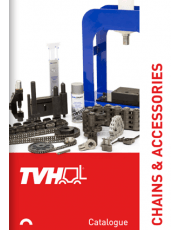5 tips to easily maintain your forklift chain
Do you also inspect your chain daily? An often overlooked but crucial action.
Forklift chains need to be regularly serviced, there is no substitute for good maintenance. A daily inspection ensures that forklifts continue to perform at optimum levels. It detects and rectifies minor problems before they affect productivity.
These 5 tips will help you prolong the lifespan of your chain and keep you safe. So focus on the wear and tear.
Tip 1: Avoid abnormal wear
Check the alignment of your chain prior to use. Make sure that the mast rollers are fitted perfectly vertical to prevent the chain from deforming or becoming stretched.
Tip 2: Use the most suitable grease
Sufficiently lubricate your chain, depending on the use and working conditions, to prevent it from corroding and keep pins and plates in place. It is vital that the chain doesn’t run dry.
Tip 3: Choose the correct chain for the correct use
An overloaded chain can - among other things - result in deformed pins. A heavier load requires a stronger chain. Find the right chain and discover how to measure the required length.
How to determine the correct chain length in the easiest way:
- Count the outer plates (marked in red)
- Multiply the # outer plates x 2
- Add 1
- Multiply this result by the pitch in mm
- Divide by 1000
This gives us the following formula: (((# outer plates x 2) + 1) x p) / 1000
The result is the chain length, expressed in meter.
Ending on inners:
Note: This formula can only be used for chains ending in the inner plates (marked in blue). If you have a chain ending on the outer plates, this has to be clearly specified in the request.
Tip 4: Use the most appropriate tool to measure the wear
Use the right chain wear gauge to determine the wear in the blink of an eye.
Measure the chain regularly to detect chain elongation and avoid working with an unsafe chain.
Tip 5: Replace the chain on time
Leaf chains must be replaced once they display an elongation of maximum 3% (or 2% in the UK and in the Netherlands). This elongation can be measured by means of a wear gauge. The measurement is performed across the piece of chain that runs over the chain roller. This part of the chain is subjected to the most stress and is therefore the ideal measuring point.
In addition to wear, there are also other potential reasons to replace a lift chain:
- twisted or shifted chain pins
- cracked chain leaf due to corrosion or metal fatigue
- seized links
- damage to the chain due to an external cause
- a fracture in the chain due to an excessive load or incorrect lubrication
Keeping the above tips in mind will help you keep the downtime of your machine as short as possible. Time is money!
Charlotte, Ninon, Maika, Laurence, TVH bloggers


